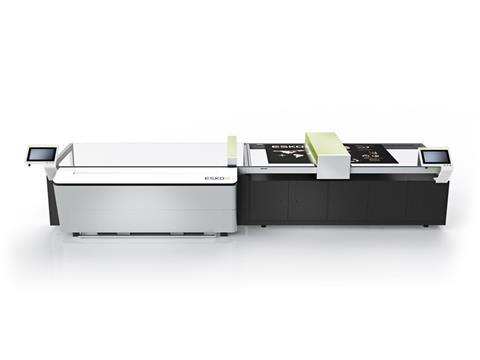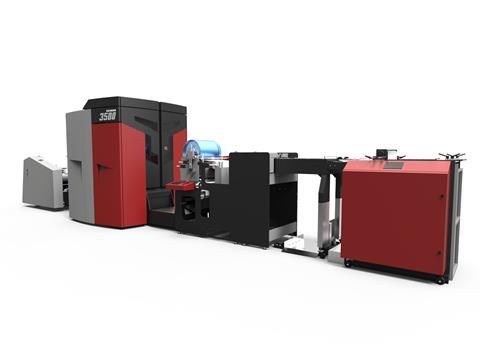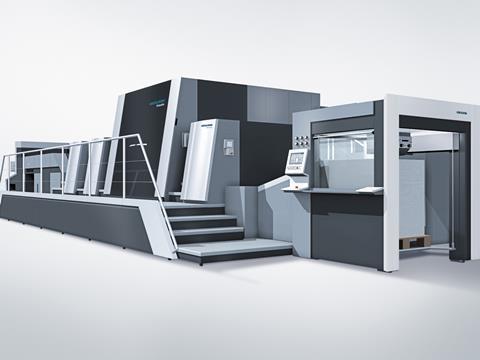
Digital printing may be playing an increasingly important role in packaging but conventional technologies are holding their own. Elisabeth Skoda spoke to Esko, Flint Group, Xeikon and Heidelberg.
Dr Eva Freudenthaler (VP Technology, Flint Group Flexographic Products) observes that strengths and weaknesses of digital and traditional printing for packaging often complement each other, and therefore the two technologies are frequently used in combination:
“Traditional print technologies in packaging production shine because of their versatility with respect to packaging substrates, the high print quality they can deliver and their industrial scale, allowing mass production at high speed and quality.”
She highlights the versatility of flexo printing for packaging applications, which can be used for printing on very thin to very thick substrates including corrugated board, on different synthetic substrates, papers and cartons.
“It can handle a wide variety of printing inks - solvent based, water based, UV and EB curing, that are formulated to adhere to the wide spread range of packaging substrates.”
However, the strength of these technologies with respect to industrial scale is also their weakness when it comes to short print runs and customisation of design. “Once set up for a specific print design these technologies on average still require higher print lengths to be economical than digital printing due to the higher prepress and set up costs.”
The primary strength of digital, on the other hand, is its capability to change the print design for every single packaging unit without extra effort and the absence of pre-press cost for printing form production and setup cost at the press.
“This makes digital printing unique when it comes to individualisation of packaging and gives digital printing technologies an advantage when only short print runs are required,” Dr Freudenthaler remarks. “Weak spots on the other hand are the printing costs for long print runs, and the print consumables like printing ink in average is still higher compared to conventional print consumables. Furthermore, digital printing inks are still not as versatile. Adhesion on the substrate as well as gloss or colour strength can be a challenge.”
Bernhard Schaaf, digital product manager at Heidelberg, highlights the advantages of digital printing.
“Lead times are going down, time to market becomes more important, and big data plays a big role. There is a trend towards more personalisation and pack variations to address customer needs. Personalisation allows companies to add value and charge a higher price for a product as every box can be unique. For example, a muesli with a custom designed pack commands a higher price than the same muesli in a generic box. Codes, vouchers and other additional information items can be integrated. Digital printing offers a range of possibilities for short runs and can also play a role in anti-counterfeiting by including codes to assure traceability.”
Ease of operation is another important point. Automation is the key behind making operation of a complex machine easy, as he explains.
“It makes sense to connect a digital world with a digital machine. There is a new level of automation and easiness of process. This trend is going to grow towards smart print shops powered by Industry 4.0. In the future, there will be less and less needs for operators when connecting the digital machine directly with the web shop.”
Kilian Renschler, from Heidelberg’s Key Account Packaging, points out that traditional sheetfed offset printing offers great flexibility, offering both long and short runs ranging from simple to highly sophisticated print jobs.
“Heidelberg’s B2 size machine offers an ideal sheet size for smaller cartons and short runs, and special finishing options for embellishing cartons.”
David Harris, Esko’s product manager, adds that for digital print, that the agility to print very short print runs enables the creation of personalised/one-off items with close to zero setup/makeready.
“This is achieved through a simpler process, without platemaking, opening the market up to new players. There is also lower cost for short print runs,” he explains.
He lists the advantages of digital print as high productivity and low cost over long print runs, great flexibility in choice of inks and the ability to print on almost any substrate, adding special effects such as metallic inks.

Digital print on the up
Filip Weymans, VP Global Marketing at Xeikon, points out that there are both market and technological drivers behind the increasing popularity of digital print in the packaging market.
“On top of increasingly looking for customisation and shorter production runs, marketers are looking for opportunities in product differentiation and segmentation. This results in an increase of SKUs for stores and warehouses, and means that stock volumes need to reduce to cope with the extra costs.”
As a technology, digital production offers a set of unique features supporting the need for customisation, for example digital embellishment or complete individualisation of a product which is impossible using traditional production techniques. These features increase dramatically the added value of the printed product.
David Harris agrees that a greater number of variants and just in time ‘lean’ production as well as zero-inventory are driving brand owners to order smaller quantities. This is perfect for digital print.
“It supports the desire to produce more innovative personalised packaging to connect with the consumer, exemplified by the success of named packaging, for example the ‘share a coke’ campaign or unique packaging such as the recent ‘Nutella Unica’ campaign, and how QR codes link to online content.”
Mr Renschler adds that a new generation of machine and production systems means that there are impressive capabilities for digital on an industrial scale.
“With the new generation of industrial digital printing machines you can work on a large scale and not just personalise a few boxes, but thousands of them. Key points are standardisation, simplification and automation of the printing process. In addition, he explains, that digital print offers consumers the possibility for self-expression by ordering individualised cartons.
“There are today possibilities to get a picture of yourself on a pack and then have it distributed via social media, which opens up new marketing possibilities.

Opening potential
A lot of the current innovations in digital production revolve around workflow and finishing possibilities, as Mr Weymans points out.
“An interesting use for digital production techniques are applications requiring security features for different types of products. The driver in this case is very often the need for better brand protection. “With digital production, there are many possibilities to include security features ranging between unique tracking codes and even custom-made security toners for 100 per cent traceability,” he explains.
Mr Harris says that there are some exciting press developments that address more types of packaging, in particular new presses for corrugated pre-print and post-print that address the complexities, quality limitations or high costs of conventional printing.
“We are seeing more combination printing, or the integration of digital and conventional print. This allow digital to be used for variable data along with conventional for what it does best such as special inks and metallic. We are also developing simple turnkey workflows like Esko’s Automation Engine for Labels that enable printers to more effectively realise the benefits of short run digital printing. There is no point having a press that can handle 100 plus jobs per day, if the bottleneck is prepress or admin,” he highlights.
Digital print offers many possibilities for future development, Mr Schaaf agrees. Integrating further processes, such as digital coating, digital embossing and die cutting will make the process chain grow further.
“An automated production line with a continuous flow could be created, without an interruption of manual work. Heidelberg supplies machines, front and back end management, software, pre-press and post press equipment. The future is not just an efficient machine, but the whole print shop working as being one single machine.”
He is keen to highlight Heidelberg’s recently launched Primefire 106, which offers customers new opportunities for digital print in folding carton production.
“Its innovative digital printing system combines the best of both worlds: The flexibility and versatility of digital printing, and the reliability and precision of the peak performance class in offset printing. This is made possible through cutting-edge drop-on-demand inkjet technology and Heidelberg’s best in class sheet transport system. Primefire offers an ideal option for quality control: If a sheet and quality is not ok, it will be immediately detected, ejected reprinted on the fly – fully automated.”
Innovations in traditional print
As a supplier of printing inks for a variety of conventional printing technologies as well as flexo printing plates Flint Group is at the forefront of innovation, as Dr Freudenthaler points out.
“Flexo printing is a very versatile packaging print technology, but compared to other conventional print technologies it is often said to be more complex in pre-press and lower in print quality than offset or gravure printing, so this is a focus for product development. With our flat top dot flexo printing plates nyloflex® FTF for flexible packaging, winner of the 2016 Flexographic Technical Innovation Award, and the recently launched nyloflex® FTC for corrugated post-print we now offer plates that can provide increased ink densities and improved ink laydown and in case of the nyloflex® FTC reduce the unwanted fluting effect in corrugated post-print.”
With regards to food packaging, low migration technology is crucial. Most ink suppliers, including Flint Group, manufacture and sell inks which are safe for food packaging. Flint Group’s ANCORA family of inks and coatings are tested and certified for label and flexible packaging applications,” Dr Freudenthaler explains.
Most recent is the marriage of low migration with UV LED.
“Flint Group offers a UV LED ink system which is also safe for food packaging. EkoCure® ANCORA, the winner of the 2017 FTA Technical Innovation Award, is the latest technology for label and package printing. This technology coupled with traditional printing methods truly transcends the traditional boundaries of narrow web.”
Mr Harris suggests that traditional print is responding to the digital challenge by becoming more agile for shorter print runs, which is making it more economically viable for short print runs.
“For example, extended gamut printing is a process that reduces or avoids ink changes on press, so greatly reducing make ready time and increasing equipment utilisation.”
Platemaking is being simplified with enhancements such as integrated imaging and exposure for flexors as in Esko Crystal XPS. This reduces the manpower needed and opens the possibility to bring platemaking in house at the converter, reducing press make ready times.
Traditional printing methods still have an important role to play in the modern printing industry, as Mr Renschler agrees.
“At Heidelberg we are addressing the trend for shorter runs. We are adding new control technology to offset to make it even more efficient. Automation increases and for example the machine is driving the make ready process automatically. Flexibility in configuration is key to keep offset attractive for short and long runs by adding embellishing possibilities.”
In conclusion, he explains the importance of quality for successful printing, embodied in latest product development:
“With the Speedmaster XL 106, we can deliver a zero-defect product. Faulty cartons can damage the brand image. It includes quality measurement and colour measurement devices, and full image checks are done while machine is operating. The machine will identify defects and eject bad sheets. This is especially important for the pharma market, where a box has to be prefect and no errors are allowed in critical areas like product name or dosage, catering for the trend for more and more inspection, not only for the printing press, but later in the process.”











